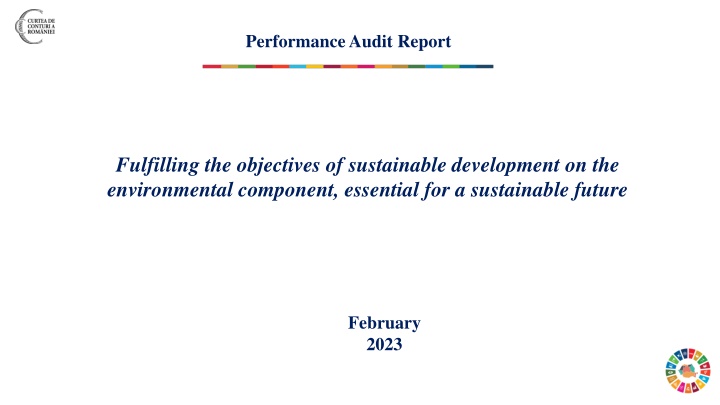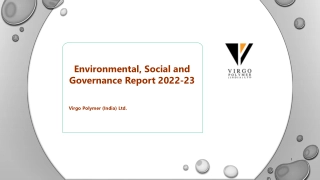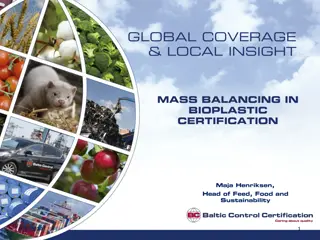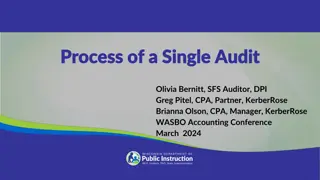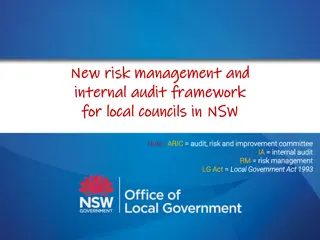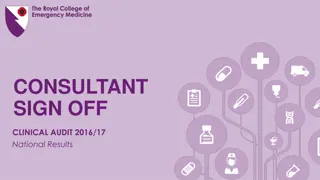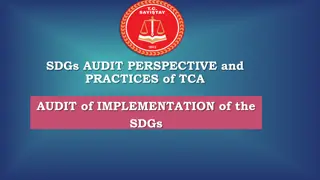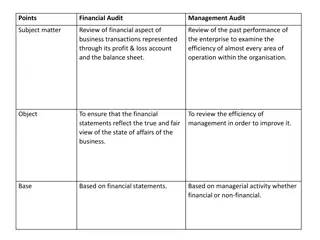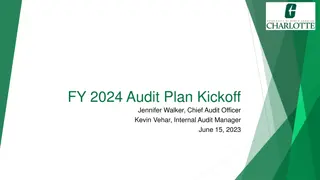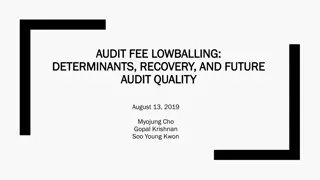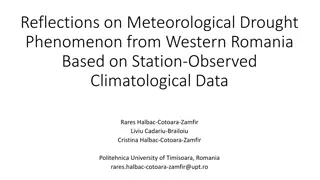Sustainability Audit Report for Romania's Environmental Development Goals
Performance Audit Report evaluating the efficiency of Romania's strategies and plans in achieving sustainable development objectives, aligned with the 2030 Agenda. Context includes national and European level strategies for a sustainable future.
Download Presentation

Please find below an Image/Link to download the presentation.
The content on the website is provided AS IS for your information and personal use only. It may not be sold, licensed, or shared on other websites without obtaining consent from the author.If you encounter any issues during the download, it is possible that the publisher has removed the file from their server.
You are allowed to download the files provided on this website for personal or commercial use, subject to the condition that they are used lawfully. All files are the property of their respective owners.
The content on the website is provided AS IS for your information and personal use only. It may not be sold, licensed, or shared on other websites without obtaining consent from the author.
E N D
Presentation Transcript
Performance Audit Report Fulfilling the objectives of sustainable development on the environmental component, essential for a sustainable future February 2023
Audit objectives Evaluation of operationalization policies and the coherence of their adoption in the strategies and implementation plans necessary for the process of achieving Romania's sustainable development objectives by MMAP . The specific objectives Objective 3 Objective 1 Objective 2 The efficiency of MMAP in order to ensure the legal framework , the strategies and the institutional organization necessary to achieve the objectives of sustainable development The efficiency of the MMAP in planning the activities necessary to implement the objectives of sustainable development. The efficiency of MMAP's achievement of the national environmental objectives regarding sustainable development.
Context Agenda 2030 - at the national level Agenda 2030 - at European level "A sustainable future for Europe"Strategy of the needs of future UN Agenda 2030 - globally "No one will be left behind" generations September, 2015 June, 2017 November, 2018 The European Commission has welcomed the new 2030 Agenda, with the European Union taking a leading position in contributing to this process from the very beginning. At the European level, the conclusions of the Council of the European Union, adopted on June 20, 2017, "A sustainable future of Europe" represent the EU's response to the 2030 Agenda Sustainable Development, which is a political document assumed by the EU member states implementation of the 2030 Agenda for Sustainable Development. The 2030 Agenda, together with the Paris Agreement on Climate Change, is the roadmap to a better world, the global framework for international cooperation on sustainable development and the economic, social, environmental and governance dimensions of this framework. In 2015, the UN General Assembly adopted the " Sustainable Development Agenda" in which the representatives of 193 governments, including Romania , signed an extremely ambitious package of sustainable development objectives, called the 2030 Agenda for Sustainable Development . This package is a universal framework for all countries to help eradicate poverty, protect the planet and ensure that all people enjoy peace and prosperity. It is an action plan for people, planet and prosperity, which seeks to strengthen a climate of safety and freedom, where "no one will be left behind". Romania, being a signatory of the UN's 2030 Agenda on sustainable development, took the initiative to integrate the agenda into the national context. Thus, Romania established its national framework through GD no. 877/2018 regarding the adoption of the National Strategy for the sustainable development of Romania 2030, which supports Romania's development on three main pillars, namely economic, social and environmental. for The 2030 Agenda of the UN contains 17 Sustainable Development Goals to which correspond 169 targets, which have the role of ensuring the balance between the three dimensions of sustainable development environmental, social and economic. The 17 SDGs are a continuation in an accelerated form of the achievement of the previous Millennium Development Goals. In 2022, the National Action Plan (NAP) was developed for the implementation of the SNDDR 2030, approved by HG no. 754/2022 and the Set of National Sustainable Development Indicators. regarding the The role of the PNA is to guide the implementation of the SNDDR 2030, in accordance with the objectives of the 2030 Agenda for Sustainable Development, in all sectoral policies, for sustainable development at the national level in the period 2022-2030.
Romanian inter-institutional framework for sustainable development
Indicators of sustainable development In March 2022, the new set of national sustainable development indicators (INDD) was developed, with a delay of almost two years. INS has developed a new set of coherent national indicators of sustainable development, which meets the requirements of SNDDR 2030 and takes into account the indicators established at the European and global level, which contains 291 indicators , of which : 99 leading indicators and192 additional indicators . The central public authorities (including units under coordination, subordination or authority) responsible for providing data are shown in the figure below: Figura I.1 Procesul de furnizare i de validare a datelor Autoritatea public Furnizare date Ajust ri, calcul indicatori Validare date i matadate INS
SDGs at national level The Ministry of Environment, Water and Forests contributes to the implementation of the following sustainable development environment: The 17 sustainable development objectives adopted in the national strategy are: objectives regarding the ODD 6 - Ap curat i sanita ie Asigurareadisponibilit ii i gestion riidurabile a apei i sanita iepentru to i ODD 11 - Ora e i comunit i durabile Dezvoltareaora elor i a a ez rilorumanepentru ca ele s fie deschisetuturor, sigure, reziliente idurabile ODD 12 - Consum i produc ie responsabile Asigurareaunor modele de consum iproduc ie durabile ODD 13 - Ac iune n domeniul schimb rilor climatice Luarea unor m suriurgente de combaterea schimb rilor climatice i a impactuluilor ODD 14 - Via acvatic Conservarea i utilizareadurabil a oceanelor, m rilor i a resurselor marine pentru o dezvoltaredurabil ODD 15 - Via a terestr Protejarea, restaurarea i promovareautiliz riidurabile a ecosistemelorterestre, gestionareadurabil a p durilor, combatereade ertific rii, stoparea irepararea degrad rii solului i stopareapierderilor de biodiversitate
Why an audit at the Ministry of the Environment? MMAP was responsible for the national implementation of the previous sustainable development strategy, Horizons 2013-2020-2030; MMAP is responsible for an important number of SDGs: SDG6 - Clean water and sanitation, SDG11 - Sustainable cities and communities, SDG12 - Responsible consumption and production, SDG13 Action in the field of climate change, SDG14 - Aquatic life, SDG15 - Terrestrial life; MMAP is responsible for providing data for a number of 27 indicators (ranks second after INS. which has 177 indicators under responsibility).
Objective 1 The efficiency of the MMAP in order to ensure the legal framework, the strategies and the institutional organization necessary to achieve the objectives of sustainable development Within this objective, the audit considered the following: the legal framework; the sectoral strategies of the ministry; the operation of the Interministerial Committee and the Sustainable Development Working Group established at the MMAP level; the institutional organization necessary to achieve the SDGs; the extent to which the ministry involved citizens and stakeholders in the processes of achieving the SDGs
Objective 1 Findings and recommendations The legal framework Finding: Recommendation: R1 : Approval of the MMAP Organization and Operation Regulation in order to clarify the attributions of the departments and update the job descriptions. The MMAP has a regulatory framework to ensure the necessary conditions for the achievement of sustainable development objectives and covers the entire mechanism, starting from the national policy regarding sustainable development, the elaboration of strategies in the field of activity, the reporting of environmental indicators and the inter- ministerial coordination of the environmental component . As a result of the reorganization institution in June 2022, the ministry developed a new ROF project , but which, at the end of the audit mission, has not yet been adopted. It was found, thus, that there was a period of more than six months in which the ministry operated based on the organizational structure approved by GD no. 677/23.05.2022, without having a segregation of duties established by an internal regulation.
Objective 1 Findings and recommendations The sectorial strategies of MMAP Recommendation: R2 . Updating the strategies provided for in art. 6 of GD no. 43/2020 and the inclusion of the Sustainable Development Objectives SNDDR 2030. The update will also take into account GD no. 379/2022 regarding the approval of the Methodology for the development, implementation, monitoring, evaluation and updating of government strategies. Finding: Chronology of the strategies developed by the ministry in relation to SNDDR 2030: Environmental provided SNDDR 2030 - HG 877/2018 by SNMRI 2010-2035 -HG 846/2010 SNPNACB 2014-2020 -HG 1081/2013 SNPNGSC 2015-2020 - HG 683/2015 SNGD 2014-2020 -HG 870/2013 SNSC 2016-2020 -HG 739/2016 SNP 2030 - HG 1227/2022 2010 2016 2030 2014 2035 2018 2020 2022 According to the legal regulations, MMAP had the obligation to update the sectoral strategies, given that several strategies expired in 2020. As seen from the Infographic in addition, between the years 2020-2022, the ministry's activities took place without being circumscribed by strategies. This factual situation leads us to the conclusion that the activity of the ministry, in the previously mentioned period, was reactive to the challenges of the moment, without pursuing the achievement of strategic objectives and targets in a clearly determined period of time.
Objective 1 Findings and recommendations Interministerial relationship Finding: Recommendation: The Interministerial Committee reorganized by GD no. 741/2011 aims to comply with and implement the objectives and recommendations regarding the integration into national, regional and local sectoral policies and strategies of the field of sustainable development and environmental protection , as formulated in the Sustainable Development Strategy of the European Union . R3. Elaboration of proposals for the review of GD no. 741/2011 and of the Regulation on the organization and operation of the Interministerial Committee approved by OMAP no. 15/06.01.2016, in order to clearly establish the attributions and courses of action for the implementation of the sustainable development objectives of SNDDR 2030 in the sectoral environmental policies. In fact , the activity of the Interministerial Committee ceased after 2018, the cause cited by the ministry being the repeal of the National Strategy for Sustainable Development - Horizons 2013-2020-2030 by art. 2 of GD no. 877/2018, interpreted by the ministry as eliminating the obligation to implement sustainable development at the national level, although the same decision provides that it will continue to coordinate the environmental protection component . Also, the harmonization of the provisions of this decision with GD no. 272/2019 in order to separate the powers and responsibilities of the Interdepartmental Committee from those of the Interministerial Committee. Another aspect regarding CI is the establishment, in 2019, of the Interdepartmental Committee for Sustainable Development according to GD no. 272/2019. So, following the analysis of the two HGs (HG no. 741/2011 and HG no. 272/2019) regarding the functioning of the above- mentioned committees, it was found that there are a number of common attributions to the two Committees, given the fact that GD no. 741/2011 has not yet been amended.
Objective 1 Findings and recommendations The sustainable development nucleus established at the MMAP level Recommendation : Finding: R4. Regulating the status of the members of the Working Group within the MMAP, by issuing a ministerial order, establishing the members' duties in order to implement the SDGs related to the institution's field of activity, etc. and including them in the job descriptions. According to SNDDR 2030, at the level of central public authorities, with attributions in the field of sustainable development, working group for sustainable development had to be established, which would aim to: the implementation of sustainable development objectives related to the institution's field of activity of which they are a part, building bridges between each responsible institution and the Department for Sustainable Development, on the one hand, and the National Institute of Statistics, on the other. We also propose that the members of the Working Group be assigned the task of analyzing and monitoring sustainable development competence of both the ministry and the units subordinated, in coordination or under authority. The result of the analysis of these indicators should be presented, in the form of a periodic report, to the management of MMAP in order to take the necessary measures in order to achieve the environmental SDGs of the 2030 Agenda. indicators under the From the analysis carried out by the audit team, it appears that the activity of the Sustainable Development Working Group had in mind the provision of the bridge between MMAP and DDD and INS. Instead , the activity of the Working Group had no contribution in taking measures by the ministry to ensure the internal framework necessary for the implementation of the SDGs related to the institution's field of activity. At the same time, we consider it beneficial that the personnel specialized in sustainable development from the units under the subordination, coordination or under the authority of the ministry should be part of the Sustainable Development Working Group of MMAP. This lack of contribution has as a possible cause the non-existence of a well-defined status of the Working Group through a ministerial order that clearly provides the attributions from which the obligation and authority of the Working Group to act for the creation of the internal framework necessary for the implementation of the SDGs emerge.
Objective 1 Findings and recommendations Horizontal and vertical institutional organization Recommendation: Finding: We findthat,although initially the ministry had a functional structure dedicated to sustainable development organized at service level, it was transformed in 2022 into a compartment, a lower level structure. The explanation of the representatives of the ministry was that after 2018 the Sustainable Development Structure had a more consultative role, given that the role of the ministry diminished with the establishment of the Department for Sustainable Development. R5. The Ministry will formalize the information flow between technical departments and units in the field of competence in order to improve the process of monitoring and reporting progress in achieving the environmental SDGs. Regarding the way of organization for the implementation of sustainable development by the units operating under, under the authority or under the coordination of MMAP, from the analysis of the audit team it emerged that only the National Agency for Environmental Protection has a Sustainable Development Office in its organizational structure to deal with this aspect. It should be mentioned that this structure has been functional since the old strategy. The effects generated by the lack of structures at the level of subordinates with clear attributions in the implementation of the 2030 Agenda lead to poor communication, to the fractional implementation of the SDGs, without adequate coordination and monitoring of the implementation of the SNDDR 2030 by the ministry. There was also a lack of clarity in the way of interaction between MMAP and the units operating under the authority, authority or coordination of the ministry to ensure a clear division of responsibilities in general, respectively for achieving the objectives and strategic targets of sustainable development and monitoring the recorded progress.
Objective 1 Findings and recommendations The extent to which the ministry involved citizens and stakeholders in the processes of achieving the SDGs Finding: It was found that on the website of the ministry in the section dedicated to sustainable development there is no more information and only at Press releases , presenting various activities of the ministry that also aim at sustainable development and sustainability. In terms of public awareness of the 2030 Agenda, there are still steps to be taken, as the information requires popularization and mediating to continuously raise awareness of the importance of the environment within the 2030 Agenda to ensure full understanding and ownership by all stakeholders. involved, public etc. In order to find out the opinion of NGOs regarding MMAP's efforts regarding the integration of sustainable development objectives, the audit team sent a questionnaire to several NGOs concerned with environmental aspects , from which the following emerged: only half of the respondents were aware of the efforts made by MMAP regarding sustainable development; the strategies of the ministry, for now, correspond to a small extent to the sustainable development of Romania ; the organizations evaluated MMAP's activity as being transparent to a small extent, having a low degree of satisfaction regarding MMAP's efforts to ensure Romania's sustainable development. From the above, it appears that MMAP must not only comply with the legal provisions regarding communication and transparency, but make additional efforts both to promote its results and to meet the expectations of civil society. For example, outlining a coherent vision and strategies, taking unpopular decisions, expediting waste management, conserving wild areas, afforestation and combating desertification, etc.
Objective 2 The efficiency of the MMAP in planning the activities necessary to implement the objectives of sustainable development Within this objective, the audit considered the following: the human resources necessary to implement the SNDDR 2030; the financial resources needed to implement the SNDDR 2030.
Objective 2 Findings and recommendations The human resources needed to implement the SNDDR 2030 Finding: Recommendation: R6. MMAP will order an analysis of the number of personnel necessary to achieve the environmental SDGs and will update the job descriptions of the people within departments involved implementation of the environmental SDGs, as well as those who obtained the "sustainable development expert" certification for responsibilities regarding sustainable development. At the time of the adoption of the SNDDR 2030, in 2018, the Ministry of the Environment had an organizational structure responsible for sustainable development, and in the audited period 2018-2022, there was a downward evolution in the number of posts within the Sustainable Development Service, from nine posts approved and filled in 2018, to a structure with one post approved and filled in 2022. the technical in the Also, the same situation is recorded in the case of the Sustainable Development Working Group established within the MMAP, which was initially composed of 12 members and which, at the time of the audit, still has 10 members, as a result of the departure of the staff from the institution. the inclusion An aspect of good practice that can positively influence the implementation of sustainable development objectives the existence of the 20 "experts in sustainable development" within the MMAP and the units subordinated, under the authority or under the coordination of the ministry.
Objective 2 Findings and recommendations Fulfillment of duties by staff responsible for sustainable development Recommendation: Finding: R7. responsibilities of MMAP according to SNDDR 2030 on component, through the lens of all the necessary steps: updating framework, developing programs/projects correlated with strategies, mechanisms for monitoring and evaluating programs/projects; strengthening sectoral and inter-sectoral coordination capacity; publication on the ministry's website of relevant information about the environmental component of sustainable development, the objectives to which the ministry contributes, results obtained, in order to promote and raise awareness of the 2030 Agenda. In the audited period 2018-2022, it was found that the specialized staff within the MMAP fulfilled duties regarding sustainable development both by participating in the working groups organized by the Department for Sustainable Development which aimed, among other things, to develop the Action Plan to achieve 2030 targets and the set of National Sustainable Development Indicators provided for in SNDDR 2030 as well as by participating in international working groups. Ensuring the fulfillment of the the environmental the legal developing intra-
Objective 2 Findings and recommendations resources needed to implement the SNDDR 2030 Finding: Recommendation: R8. In order to improve the planning of the financial resources necessary to implement the strategic objectives, we recommend updating the PSI based on the provisions of GD 427/2022 regarding the strategic planning methodology, correlated with the implementation of GD 467/2022 regarding the Methodology for the development and execution of budget programs, which specifies the form of presentation of budget programs, their content and the way of developing the result and/or efficiency indicators, as well as the way of monitoring the execution of the budget programs. Since the MMAP did not envisage a mechanism for integrating the objectives of sustainable development on the environmental component into the sectoral strategies, a medium and long-term planning of the necessary financial resources was not carried out. However, a positive aspect that must be continued is the experience gained by MMAP through involvement in collaboration with SGG to strengthen planning and budgeting capacity and support the introduction of budgeting based on performance criteria, which resulted in the Institutional Strategic Plan 2019-2022. Currently, the old strategic planning methodology has been updated by GD no. 427/2022. Likewise, the methodology regarding the budget programming component was updated and taken over in GD no. 467/2022 on the methodology for the development and execution of budget programs, which specifies the form of presentation of the budget programs, their content and the way of developing the result and/or efficiency indicators, as well as the way of monitoring the execution of the budget programs. The implementation of this recommendation will lead both to the budgeting of the strategic objectives of the MMAP in general, and to complianceSpecific Objective 2: The national budget planning framework for the implementation of budgeting based on the SDGsfrom the National Action Plan for the implementation of SNDDR 2030.
Objective 3 The efficiency of achieving, by MMAP, the national environmental objectives regarding sustainable development Within this objective, the audit considered the following: the contribution of MMAP in achieving the environmental SDGs; the extent to which the ministry has established an effective, transparent and comprehensive system for measuring, monitoring and reporting progress towards achieving national sustainable development targets;
Objective 3 Findings and recommendations The contribution of MMAP in achieving the environmental SDGs Finding: measures taken at the MMAP level to achieve the environmental SDGs It was found, thus, that at the level of the technical directions of the ministry, after the adoption of the SNDDR 2030, no specific measures were taken, on their own initiative, to update the sectoral strategies and include the objectives of sustainable development, which would lead to the fulfillment of their related targets as following Romania's acceptance of an international document - the UN Agenda 2030. However, the only strategy that takes the SDGs into account was the one for forests, adopted in 2022, so the effects will be quantified in the following years. measures taken at the level of the units under the competence of MMAP Most of the units provided in the annex to GD no. 43/2020 carries out a series of activities that contribute to the achievement of sustainable development objectives. Here are some examples: The National Agency for Environmental Protection aims to achieve sustainable development targets through the actions provided for in the Local Environmental Action Plans developed at the level of each county and the Municipality of Bucharest. Administration of the Danube Delta Biosphere Reserve, byThe management plan has established objectives that fall under the 17 objectives of the National Strategy for the Sustainable Development of Romania 2030. Agency for Natural Protected Areas is currently implementing a number of four projects with partners based on the provisions of Art. V of Law no. 220/2019 regarding the modification and completion of some normative acts in the field of environmental protection.
Objective 3 Findings and recommendations Managing the risks in the implementation of national sustainable development targets Recommendation: Finding: R9. Taking measures by MMAP regarding the causes identified as generating risks that affect the implementation development in order to reduce the level of risks. According to the analysis of the data recorded in the Risk Register, it was found that, for the objective taken as an example (OG.7 Sustainable development and reduction of greenhouse gas emissions from economic activities in accordance with EU targets and adaptation to the impact of climate change, both the current , as well as future ones) , that the level of risks remained the same, which means that the measures taken by MMAP were insufficient to reduce the level of these risks . In the same situation are the risks related to the other objectives. Regarding the way of elaborating, updating and monitoring the sectoral strategies, the audit team found that this risk monitoring activity is not processed at the level of any specialized technical direction of the ministry. of sustainable
Objective 3 Findings and recommendations Coordination, collaboration and communication between the institutions responsible for the implementation and achievement of sustainable development objectives Recommendation: Finding: R10. The reanalysis by MMAP together with DDD of the mode of coordination, collaboration communication sustainable development, in order to standardize the interaction between central public authorities and subordinate units with responsibilities implementation of SNDDR 2030. It was found that the existing coordination, collaboration and joint process between the coordinating institutions and subordinate entities with implementation sustainable development objectives does not seem to be an effective one, as there is no clear segregation of duties between the parties involved in the implementation of the strategy. and regarding and achievement of administrative in the
Objective 3 Findings and recommendations The stage of achievement of the sustainable development objectives related to the environment Recommendation: R11 . Monitoring and analyzing the data presented in the statistical data aggregator in the field of sustainable development promoted by the Department for Sustainable Development, in order to reflect a real picture of the environmental SDGs. Finding: Currently, at the MMAP level, there is no mechanism for monitoring and reporting progress towards the implementation of the SNDDR 2030, and no information regarding them can be found on the MMAP website. The answers received from MMAP representatives in relation to the monitoring of sustainable development indicators referred to the national mechanism created by SNDDR 2030, through which the Department for Sustainable Development is the main coordinator of the implementation activities necessary to achieve the 17 sustainable development objectives - ODD of the Agenda 2030. Given the fact that the indicators were updated in 2022, the data on the INS website are not complete, some data series are up to 2019, others up to 2020. R12 . Initiating consultations with DDD and INS in order to harmonize the set of national indicators to meet the reporting requirements of the European Environment Agency (EEA), according to the proposal formulated by ANPM.
Objective 3 Findings and recommendations The degree of adequacy of sustainable development targets, synergies and conditionality between objectives Recommendation: Finding: R13. reevaluate sustainable targets and indicators related to the component, taking into account the proposals presented in annex of our report. Initiating steps national development to Following the analysis of the interactions that the environmental objectives and targets have on the other sustainable development objectives and the extent to which these targets are appropriate, it was found that certain targets are not appropriate and certain indicators are irrelevant. the environmental
Objective 3 Findings and recommendations The extent of the interactions between the four analyzed environmental objectives and the other sustainable development objectives are presented in the infographic below: ODD 1 ODD 2 ODD 3 ODD 4 ODD 5 ODD 6 ODD 7 ODD 8 ODD 9 ODD 10 ODD 11 ODD 12 ODD 13 ODD 14 ODD 15 ODD16 ODD 17
Romania's position at the European level 2020 2022 The green quadrant is the optimal one, while the pink one shows the regression in achieving the goals. Comparing the graphs presented in the EU reports from 2020 and 2022, it is rather a regression of Romania's status, in which the status of the SDGs, instead of moving towards the green zone, disperses towards the regression zone, so it is obvious that they are further measures and sustained efforts are needed at all levels, local, regional and national.
Conclusions of the European Commission The conclusions of the European Commission reinforce the findings of the Court of Auditors with reference to the achievement of the objectives of sustainable development on the environmental component, namely: better strategic planning is needed to create the necessary framework to achieve the objectives; better coordination at governmental, inter-institutional and inter-sectoral level is needed; it is recommended to switch to program budgeting to ensure funding sources; achieving appropriate prioritization of measures/actions to maximize results; administrative capacity must be strengthened; communication and participation of citizens and other interested parties in the field of sustainable development on the environmental component.
The main audit raport message Next, we present the time horizon starting from 2008, when the second National Sustainable Development Strategy Horizons 2013-2020- 2030 was adopted, continuing with the year 2018 in which the SNDDR 2030 was adopted, with the year 2022 in which the The national action plan and set of national indicators in 2022, and up to the deadline of 2030, towards which we are moving rapidly. The remaining time is short, and efforts towards achieving the SDGs targets and objectives must be continued and accelerated with a focus on results. Perioada de timp r mas pentru implementare Agenda 2030 Strategia na ional pentru dezvoltarea durabil a Rom niei 2030 aprobat prin HG 877/2018 Termen de realizare a obiectivelor de dezvoltare durabil 2008 2022 Atingere ODD i inte SNDDR nerealizate 2030 2018 Planul na ional de ac iune pentru implementarea SNDDR 2030 aprobat prin HG nr.754/2022 Setul de indicatori na ionali de dezvoltare durabil Strategia na ional pentru dezvoltare durabil aprobat prin HG nr.1460/2008
End of presentation Thank you for your attention! If you have any questions or want additional clarifications, you can send them to us at the email address: International.romania@rcc.ro or directly to our PAS representative, Mr. Adrian Gogolan at the email address: adrian.gogolan@rcc.ro
